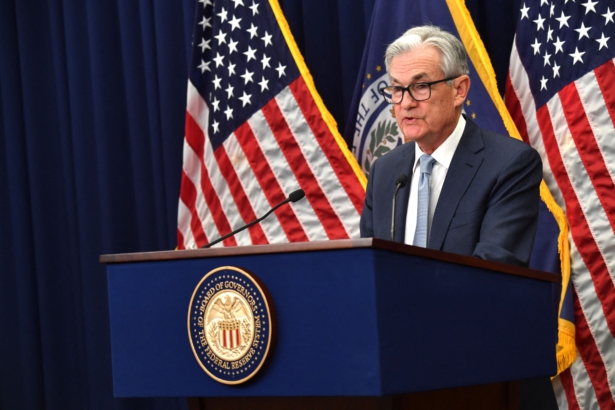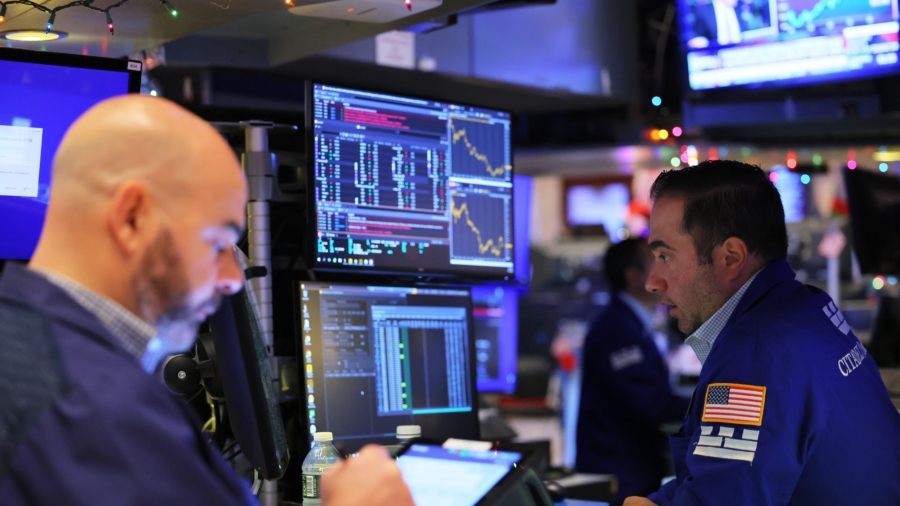The U.S. stock market suffered one of its worst days of 2022 as the leading benchmark indexes fell sharply on Thursday, dashing hopes of a year-end Santa Claus rally.
Investors engaged in a broad-based selloff toward the end of the trading week. The Dow Jones Industrial Average (DJIA) plummeted as much as 919 points. The tech-heavy Nasdaq Composite Index plunged nearly 400 points, while the S&P 500 Index lost as much as 115 points.
Year to date, the Nasdaq has lost 30 percent, the S&P 500 has tumbled 18 percent, and the DJIA has slumped more than 8 percent.
Some of the biggest names on the New York Stock Exchange endured steep losses. Shares of Alphabet, Amazon, and Apple lost roughly 4 percent. Meta shed close to 6 percent, while Netflix plummeted 8.5 percent. Bank shares also slumped, with Bank of America and JPMorgan Chase declining 2 percent.
Some of the stocks to record gains were Verizon Communications (1 percent), Allstate Corp. (1.92 percent), Coterra Energy (2.69 percent), and D.R. Horton (2.7 percent).
Traders sought shelter in traditional safe-haven assets. The benchmark 10-year yield shed roughly 6 basis points, to around 3.44 percent. The U.S. Dollar Index (DXY), which gauges the greenback against a basket of currencies, surged above 104.00.
Recession Concerns Drive Selloff
Weak economic data spooked markets.
According to the Census Bureau, retail sales tumbled 0.6 percent month over month in November. This is down from the 1.3 percent increase in October and below the market projection of a 0.1 percent drop. It represented the largest slide this year, led by declines in sales for furniture (negative 2.6 percent), building materials (negative 2.5 percent), motor vehicles (negative 2.3 percent), and electronics (negative 1.5 percent).
Manufacturing numbers also added to widespread recession concerns. Last month, industrial and manufacturing production slid 0.2 percent and 0.6 percent, respectively. The New York Empire State Manufacturing Index weakened to negative 11.2, while the Philadelphia Fed Manufacturing Index came in at a worse-than-expected negative 13.8.
Labor numbers were mixed as initial jobless claims tumbled to 211,000 for the week ended Dec. 10, Department of Labor numbers show (pdf). But continuing jobless claims edged up to 1.671 million.
The latest statistics prompted the Federal Reserve Bank of Atlanta to trim its fourth quarter GDPNow model to 2.8 percent, down from the previous estimate of 3.2 percent.
S&P Global will also release its composite, manufacturing, and services Purchasing Managers’ Index (PMI) readings for December on Friday. The PMI prints, which show the general direction of economic sectors, are expected to remain in contraction territory.
Fed Fuels Freefall?
In late 2018, Fed Chair Jerome Powell turned hawkish and weighed the possibility of raising interest rates. This prevented a rally in the days leading up to Christmas, according to Nancy Tengler, the CEO and CIO at Laffer Tengler Investments.
“Let’s not forget that Jay Powell wrecked a Santa Claus rally in 2018 when he got very hawkish and talked rates up and then the market basically went into a bear market until Christmas Eve,” she said in a note. “So, I think you want to remain vigilant and focused on the long term. I’m expecting a rally, and I’m hoping for a rally, but we don’t know for sure when we will get it.”
Did history repeat itself on Thursday? Financial markets were not encouraged by Powell’s comments during his post-Federal Open Market Committee (FOMC) meeting news conference. He reaffirmed to reporters that the central bank will continue hiking interest rates throughout 2023, with the benchmark federal funds rate expected to peak at a higher-than-expected 5.1 percent.
The Fed raised interest rates by 50 basis points on Wednesday, bringing the target rate to a range of 4.25–4.5 percent, the highest level in 15 years.
Despite the better-than-expected November CPI data of 7.1 percent, Powell noted that he wants to see a persistent downward trend in inflation before easing its tightening cycle.
“So, we may have to raise rates higher to get to where we want to go,” Powell said. “And that’s really why we’re rounding down. We’re expecting that they’ll have to remain high for a time.”

Ultimately, the Fed will wait for more data to be convinced that inflation is steadily declining.
“Never forget the unspoken rule of central banks: do whatever it takes to avoid embarrassment,” said Christian Hoffman, the portfolio manager and managing director at Thornburg Investment Management.
Powell also conceded that it is “not going to feel like a boom” in the U.S. economy but rather “it’s going to feel like very slow growth.”
The Survey of Economic Projections (SEP) showed that the GDP growth rate will be sluggish over the next three years: 0.5 percent (2023), 1.6 percent (2024), and 1.8 percent (2025). The median unemployment rate is forecast to run at 4.6 percent (2023), 4.6 percent (2024), and 4.5 percent (2025). The Fed is expected to reach its 2 percent target rate in 2024.
Because economic conditions are holding steady, Hoffman thinks the market is not completely dismissing the possibility of a soft landing.
“This was the last big known unknown on the 2022 calendar. Investors broadly are closing the books on 2022 and looking to 2023,” he wrote in a note.
In the end, the biggest risk facing the financial markets is the central bank going too far, added Tengler.
“The bond market seems to think the Fed should be wrapping up here,” she stated. “You are starting to hear CEOs and strategists blame the Fed. [Economist Mohamed] El Erian: one of the biggest policy mistakes in history. Because Powell’s Fed has made many mistakes, has lagged the markets, and flip-flopped, this is a reasonable worry.”
Next year, as higher interest rates work their way through the system, investors might focus more on the real economy and determine if the United States is bracing for tepid growth, a short and shallow recession, or a deep economic downturn.
From The Epoch Times

